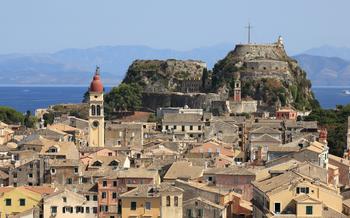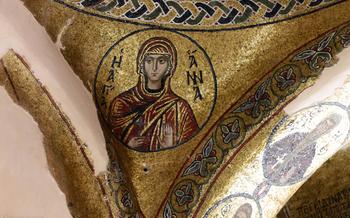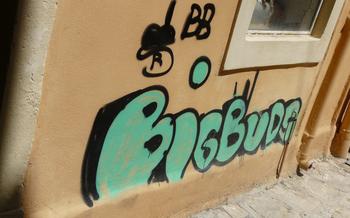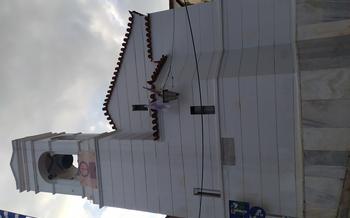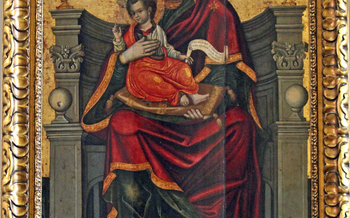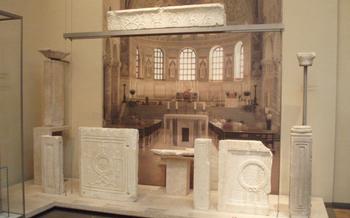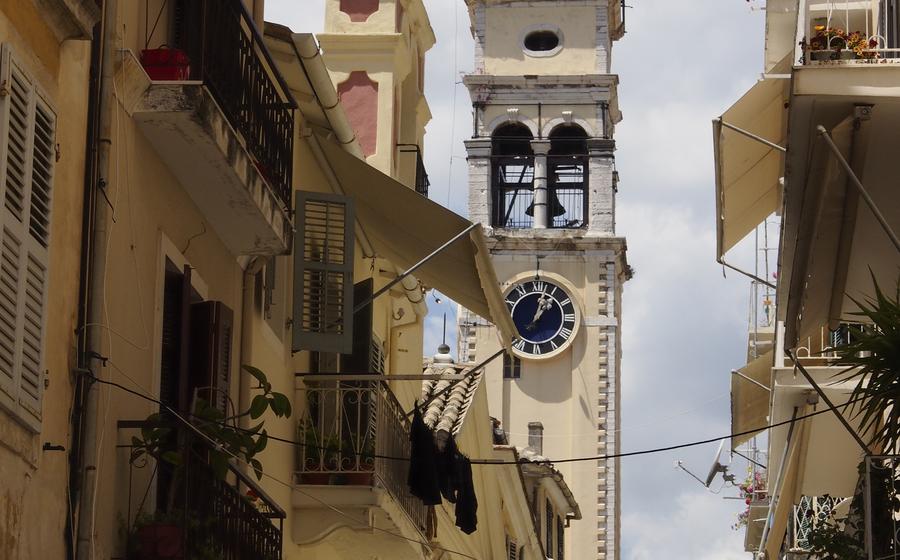
Saint Spyridon Church
- The Saint Spyridon Church: An Overview
- Unveiling the History of Saint Spyridon
- Exploring the Architectural Marvel
- Religious Significance and Celebrations
- Awe-Inspiring Interior
- Divine Relics of Saint Spyridon
- Experiencing the Divine Liturgy
- A Place of Worship and Serenity
- The Miraculous Interventions
- Local Customs and Traditions
- Events and Festivals
- Nearby Attractions
- Insider Tip: A Unique Experience
The Saint Spyridon Church: An Overview
Nestled in the heart of Corfu Town, the Saint Spyridon Church stands as a beacon of faith and spirituality, attracting pilgrims and visitors from around the world. Dedicated to Saint Spyridon, the patron saint of Corfu, this magnificent edifice holds immense historical, architectural, and religious significance.
Historical Significance
The Saint Spyridon Church has a rich and storied history dating back to the 16th century. Originally built as a small chapel in 1527, it underwent significant expansion and renovation over the centuries, reflecting the evolving architectural styles and the growing devotion to Saint Spyridon. The church's current form, with its impressive façade and distinctive bell tower, was largely completed in the 17th century.
Architectural Style
The Saint Spyridon Church is a remarkable blend of Byzantine and Venetian architectural styles, showcasing the diverse influences that have shaped Corfu's cultural heritage. The church's exterior features intricate carvings, elegant arches, and a striking bell tower, while the interior boasts a grand iconostasis, exquisite chandeliers, and vibrant murals depicting biblical scenes.
Religious Importance
As the patron saint of Corfu, Saint Spyridon holds a special place in the hearts of the island's residents. The church serves as a major pilgrimage site, attracting devout believers seeking solace, guidance, and miraculous interventions. The incorrupt body of Saint Spyridon, believed to possess healing powers, is a focal point of veneration, drawing pilgrims from far and wide.
Location and Accessibility
The Saint Spyridon Church is conveniently located in the heart of Corfu Town, just a short walk from the main square, Spianada. It is easily accessible by foot, public transportation, or taxi. Visitors can explore the church independently or join guided tours that provide insights into its history, architecture, and religious significance.
Unveiling the History of Saint Spyridon
The life of Saint Spyridon is shrouded in mystery and legend, but his unwavering faith and miraculous deeds have left an indelible mark on the history of Christianity. Born in the 3rd century AD in Cyprus, Saint Spyridon was a humble shepherd who devoted his life to serving the poor and needy. His reputation for kindness and compassion spread far and wide, and he soon became known as a miracle worker, performing extraordinary feats such as raising the dead, healing the sick, and casting out demons.
In the year 325 AD, Saint Spyridon was summoned to attend the First Ecumenical Council of Nicaea, where he fearlessly defended the divinity of Jesus Christ against the Arian heresy. His eloquent speech and unwavering faith convinced many doubters, and he played a pivotal role in shaping the Nicene Creed, which remains the foundation of Christian belief to this day.
Following the council, Saint Spyridon returned to Cyprus, where he continued to perform miracles and spread the Gospel. After his death, his relics were enshrined in a church in Tremithousa, where they remained for centuries. In 1453, when the Ottoman Turks conquered Cyprus, the relics of Saint Spyridon were taken to Constantinople, the capital of the Byzantine Empire.
In 1539, the Venetian Republic, which had ruled Corfu since the 14th century, requested that the relics of Saint Spyridon be transferred to the island. The Venetians believed that the presence of the saint's relics would protect Corfu from Ottoman invasion. The relics arrived in Corfu on August 11, 1544, and were greeted with great jubilation by the local population.
Since then, Saint Spyridon has been revered as the patron saint of Corfu, and his relics have become a symbol of hope and faith for the island's inhabitants. The Saint Spyridon Church has become a major pilgrimage site, attracting thousands of devotees from all over the world who come to seek the saint's intercession and to venerate his incorrupt body.
Exploring the Architectural Marvel
The Saint Spyridon Church stands as a testament to the harmonious blend of Byzantine and Venetian architectural styles. Its exterior façade is adorned with intricate carvings and frescoes, showcasing the skillful artistry of its creators. The majestic bell tower, a prominent feature of the church, rises towards the sky, inviting the faithful to come and worship.
Inside, visitors are awe-inspired by the exquisite craftsmanship that adorns every corner of the church. The iconostasis, a magnificent wall of icons separating the sanctuary from the nave, is a masterpiece of Byzantine art, featuring intricate carvings and depictions of religious figures. Exquisite chandeliers and oil lamps illuminate the interior, casting a warm and inviting glow.
The walls are adorned with murals depicting biblical scenes, adding a touch of divine beauty to the sacred space. The sacred relics of Saint Spyridon, including his incorrupt body, are housed in a silver reliquary, attracting pilgrims from far and wide who come to pay their respects and seek his blessings.
Religious Significance and Celebrations
Saint Spyridon is deeply revered as the patron saint of Corfu, and his feast day on December 12th is a major religious and cultural event on the island. During this annual celebration, the saint's relics are carried in a grand procession through the streets of Corfu Town, accompanied by thousands of devoted pilgrims and locals. The procession is a spectacle of faith and devotion, as the faithful chant hymns and carry candles, creating a mesmerizing atmosphere of spirituality and reverence.
Saint Spyridon is widely believed to have performed numerous miracles throughout history, and his interventions are a testament to his enduring power. Devotees from all corners of the world come to Corfu to seek his intercession and pray for his blessings. They share stories of miraculous healings, answered prayers, and divine guidance, further solidifying the saint's reputation as a miracle worker. The unwavering faith of these devotees is a testament to the deep connection they feel with Saint Spyridon and the profound impact he has had on their lives.
Awe-Inspiring Interior
The interior of the Saint Spyridon Church is a testament to the grandeur and devotion of the faithful. The iconostasis, a magnificent screen separating the nave from the sanctuary, is adorned with intricate carvings and exquisite icons depicting scenes from the life of Christ and the saints.
The chandeliers and oil lamps, suspended from the ceiling, cast a warm and ethereal glow, illuminating the sacred space. The walls are adorned with murals depicting biblical scenes, adding to the spiritual ambiance.
The sacred throne and altar, located in the apse, are adorned with precious stones and intricate carvings, symbolizing the divine presence within the church. The throne, where the bishop presides over religious ceremonies, is a masterpiece of craftsmanship, showcasing the artistry and devotion of the church's builders.
Divine Relics of Saint Spyridon
The Saint Spyridon Church in Corfu holds one of the most revered relics in the Orthodox Christian world - the incorrupt body of Saint Spyridon himself. Remarkably preserved for centuries, the saint's remains are a testament to his enduring spiritual power and the unwavering faith of his devotees.
Veneration of Saint Spyridon's relics is a central aspect of the church's significance. Pilgrims from around the world flock to Corfu to pay their respects and seek blessings from the saint. The faithful line up patiently to touch the relics, often placing their hands on the glass casket in a gesture of devotion and prayer.
Miraculous healings and blessings are frequently attributed to Saint Spyridon's intercession. Devotees share stories of miraculous cures, restored health, and answered prayers after touching the relics or seeking the saint's guidance. The unwavering belief in Saint Spyridon's miraculous powers continues to inspire and comfort countless believers.
A unique tradition associated with the relics is the changing of Saint Spyridon's slippers. Every year, on major feast days, the slippers covering the saint's feet are carefully replaced with new ones. This symbolic gesture represents the continuous presence and protection of Saint Spyridon among his devoted followers.
Experiencing the Divine Liturgy
The Saint Spyridon Church invites devotees to immerse themselves in the spiritual essence of the Divine Liturgy, a solemn and sacred ritual that transports participants to a realm of profound devotion. The service, conducted in the ancient Byzantine tradition, unfolds with an air of reverence and mysticism, captivating the senses and elevating the soul.
The rhythmic chanting of prayers and hymns fills the air, creating a harmonious melody that resonates with the sacredness of the occasion. The melodious voices of the choir blend beautifully, weaving a tapestry of sound that uplifts the spirits and draws worshippers closer to the divine.
As the service progresses, the congregation stands and kneels in unison, following the intricate choreography of the liturgy. Moments of silent contemplation and heartfelt prayers alternate with periods of collective exaltation, creating a dynamic and engaging experience for all who participate.
The culmination of the Divine Liturgy is the Holy Communion, a sacred rite in which believers partake in the bread and wine, representing the body and blood of Christ. With reverence and humility, devotees approach the altar to receive this holy sacrament, deepening their connection with the divine and seeking spiritual nourishment and grace.
Participating in the Divine Liturgy at the Saint Spyridon Church is not merely a religious obligation; it is an opportunity for spiritual transformation and communion with the divine. Pilgrims and visitors alike are welcome to join this sacred gathering, experiencing the profound beauty and transformative power of the Byzantine tradition.
A Place of Worship and Serenity
The Saint Spyridon Church exudes an atmosphere of tranquility and serenity, inviting visitors to seek solace and guidance within its sacred walls. Devotees from all walks of life come here to find comfort, pray for divine intervention, and connect with the spiritual presence of Saint Spyridon. The church serves as a refuge for contemplation and prayer, where individuals can escape the hustle and bustle of everyday life and find solace in the presence of the divine. It is a place where faith flourishes, and hope and serenity prevail, reminding visitors of the enduring power of spirituality and the profound impact it can have on the human soul.
The Miraculous Interventions
Saint Spyridon is revered as a miracle worker, and countless stories of healing and answered prayers have been attributed to his intercession. Devotees from all corners of the world have flocked to the Saint Spyridon Church, seeking solace and divine intervention.
Miraculous healings, recoveries from life-threatening illnesses, and seemingly impossible favors granted have solidified Saint Spyridon's reputation as a powerful intercessor. Devotees often leave written accounts of their experiences, expressing their gratitude and unwavering faith in the saint.
One such story erzählt of a young woman who suffered from a debilitating illness. After years of seeking medical help without success, she turned to Saint Spyridon in desperation. She visited the church, prayed fervently, and touched the saint's relics. Miraculously, she experienced a complete recovery, attributing her healing to the saint's divine intervention.
Another story recounts the miraculous rescue of a shipwrecked sailor. Caught in a violent storm, the sailor's vessel was on the verge of sinking. In his despair, he called upon Saint Spyridon for help. To his astonishment, the storm suddenly subsided, and the ship was guided safely to shore. The sailor, filled with gratitude, vowed to visit the Saint Spyridon Church to offer his thanks.
These are just a few examples of the countless miracles attributed to Saint Spyridon. Devotees from all walks of life continue to seek his intercession, believing in his unwavering love and compassion. Whether it's healing from illness, guidance in difficult times, or answered prayers, Saint Spyridon's divine presence is felt by all who come to him with faith and devotion.
Local Customs and Traditions
The Saint Spyridon Church is deeply embedded in the local customs and traditions of Corfu. Here, the church serves as a gathering place for the community, a witness to life's milestones, and a source of spiritual guidance.
One notable custom is the lighting of olive oil lamps. Devotees offer these lamps as a symbol of their faith and gratitude, illuminating the church with a warm, flickering glow. The flickering flames represent the eternal presence of Saint Spyridon, guiding and protecting his followers.
Another tradition is the leaving of votive offerings. These offerings, often in the form of small metal objects, express the devotees' gratitude for answered prayers or seek the saint's intercession in times of need. They serve as tangible reminders of the deep connection between the community and their patron saint.
The church also plays a significant role in the local community, hosting various events and initiatives. These include religious festivals, cultural performances, and exhibitions, which bring the community together and celebrate the rich heritage of Corfu.
To fully appreciate the cultural significance of the Saint Spyridon Church, it is important to observe and respect local customs and beliefs. Visitors should dress appropriately, maintain a respectful demeanor, and refrain from disruptive behavior. By embracing the local traditions, visitors can immerse themselves in the spiritual and cultural heart of Corfu.
Events and Festivals
The religious life of Corfu is vibrant and colorful, with various events and festivals taking place throughout the year. The most significant event is the annual feast day of Saint Spyridon, celebrated on December 12th. On this day, a grand procession carrying the saint's relics through the streets of Corfu takes place, attracting thousands of devotees and visitors. The procession is accompanied by marching bands, choirs, and traditional dances, creating a festive and joyous atmosphere.
Other religious festivals observed in Corfu include Easter, Christmas, and the feast days of other local saints. These festivals are marked by church services, processions, and traditional celebrations. Visitors can also enjoy cultural performances, art exhibitions, and local food fairs during these festive occasions. The fusion of religious devotion and cultural expression makes Corfu's festivals a unique and unforgettable experience.
Nearby Attractions
Beyond the spiritual allure of Saint Spyridon Church, Corfu beckons visitors with an array of captivating attractions. Delve into the heart of Corfu Town, a UNESCO World Heritage site, where Venetian and British influences harmoniously blend in the labyrinthine streets, pastel-hued buildings, and charming piazzas. Embark on a historical journey as you explore the Old Fortress, a testament to Corfu's rich past, or uncover the secrets of the New Fortress, offering panoramic vistas of the island.
For those seeking spiritual solace, Corfu is home to several other significant churches and monasteries. The Church of Panagia Spiliotissa, nestled amidst lush greenery, boasts a stunning collection of Byzantine icons. The Monastery of Paleokastritsa, perched atop a dramatic cliff, offers breathtaking views of the Ionian Sea and houses a revered icon of the Virgin Mary.
Nature enthusiasts will revel in Corfu's unspoiled beauty. Explore the verdant landscapes of Mount Pantokrator, the island's highest peak, and soak in the panoramic vistas from its summit. Wander through the enchanting Ropa Valley, a haven of olive groves, vineyards, and traditional villages. Discover hidden coves and pristine beaches along Corfu's scenic coastline, ideal for swimming, sunbathing, and water sports.
Corfu seamlessly blends pilgrimage with sightseeing, offering a diverse range of experiences. Whether you seek spiritual enlightenment, historical exploration, or natural wonders, this captivating island has something to offer every traveler.
Insider Tip: A Unique Experience
For an unforgettable encounter, plan your visit to coincide with the changing of Saint Spyridon's slippers ceremony, a sacred ritual that takes place every morning. This unique tradition involves replacing the saint's worn-out slippers with a new pair, symbolizing his continuous journey and the belief that he is always present among his devoted followers.
Witnessing this ceremony is a rare opportunity to immerse yourself in the spiritual essence of the church and gain a deeper understanding of Saint Spyridon's enduring legacy. The changing of the slippers is performed with reverence and devotion, accompanied by prayers and hymns, creating a deeply moving and inspiring experience.
As you observe the intricate details of the new slippers, adorned with symbols and embroidery, you will be reminded of the saint's miraculous interventions and the unwavering faith of his devotees. This ritual serves as a testament to the enduring bond between Saint Spyridon and the people of Corfu, who continue to seek his guidance and protection.
Whether you are a devout believer or simply seeking a unique cultural experience, attending the changing of Saint Spyridon's slippers is an unforgettable highlight that will leave a lasting impression. It offers a glimpse into the heart of Corfu's religious traditions and the profound reverence for Saint Spyridon, the beloved patron saint of the island.
